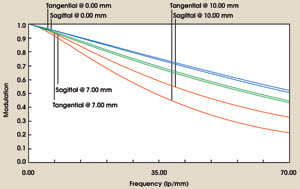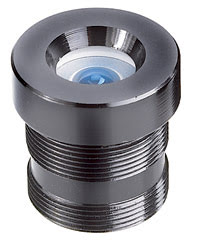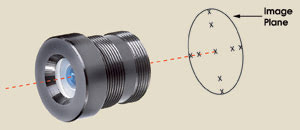Production modulation transfer function instrumentation is a major departure from traditional lab equipment.
Samuel P. Sadoulet, Edmund Optics
Although resolution has historically been a dominant parameter of image quality, it is clear that contrast also plays an instrumental role, particularly in terms of the speed and accuracy of machine vision systems. It should be noted that resolution and contrast are inherently linked; specifying the limiting resolution of an imaging system without a notion of contrast makes little sense.
The modulation transfer function is an elegant way to characterize how well an imaging system transfers contrast as a function of object detail; i.e., resolution. As the object details get smaller, it becomes increasingly difficult for the system to transfer its contrast to the image. This property is typically represented as a plot of contrast — modulation — vs. object detail — frequency. This graph gives a clear indication of the lens’ performance within different frequency ranges (Figure 1).

Figure 1. A modulation transfer function curve clearly indicates how well the lens performs at various frequency ranges.
The advantage of specifying image quality in terms of modulation transfer function is that it is an objective measurement. Although visual tests have been and continue to be used, all are subjective. The dependence on human perception has limitations in a manufacturing world where more hard data and recordkeeping have become necessary. Beyond this objectivity, modulation transfer function is extremely useful in determining how component performance affects system performance and application requirements.
Many components of an imaging system, such as the lens and the camera, have an associated modulation transfer function curve, and the overall measurement can be obtained by multiplying those of all individual components (Figure 2). This enables an accurate prediction of system performance by examining the components’ specifications. Analyzing these curves can be a valuable tool in matching up components properly during system integration.

Figure 2. By combining curves, a designer can match components and predict how a system will perform. In this example, the curves for a typical 25-mm, f/4 lens with a fixed focal length are multiplied by those for a typical CCD camera to determine system performance. Resolution is given in lines per millimeter.
On the factory floor
Modulation transfer function does present some drawbacks, specifically in terms of the metrology necessary to support it in production environments. Speed of measurement, for instance, has been problematic. It can take 15 to 20 minutes to characterize a lens. Stability of modulation transfer function measurement instruments also has been an issue because hardware developed for laboratory environments was deployed onto the production floor. Calibration and correlation of instruments continues to be challenging. The inherent sensitivity of modulation transfer function and the large amount of data necessary to represent it correctly make it one of the hardest optical specifications to correlate between instruments.
Despite these problems, modulation transfer function presents overwhelming advantages for integrators and, therefore, has become a preferred method for designers to specify the quality of an optical element coming off the production line. Thus, manufacturers are forced to deal with this metrology in production environments, motivating many of them to develop internal production-ready instrumentation that strikes a proper balance among speed, repeatability and data management.
Speed is vital. In these applications, the instruments must make full lens characterization within four to seven seconds. The need for this incredible speed stems from the fact that one modulation transfer function instrument typically is used to control the output quality from numerous assemblers. In these applications, trays of lenses are often loaded and unloaded semiautomatically. The new generation of instrumentation is a major departure from traditional modulation transfer function lab equipment (Figure 3).

Figure 3. On the production floor, modulation transfer function instruments must provide fast andrepeatable measurements. Data management is not a trivial undertaking. Courtesy of Edmund Optics.
Speed is not the sole requirement for production-ready instrumentation, however. Accuracy and repeatability also are critical, with the latter being significantly more important in volume production. Getting repeatable results is crucial for observing trends of quality during production. Having the proper controls to actively monitor quality is key to running a factory floor and ensures that the customer gets consistent performance throughout the lifetime of the product.
Calibration
Although many articles have been published in regard to calibration, basic issues still are associated with some of these techniques. The need for correlation between different instruments is absolutely critical and not trivial. It is essential that both parties consider lens orientation, field weights and definition, and frequency definition for proper “best focus” position, and that they consider the spectral content and stability of the source. We have found that it is easier to gather all through-focus data so that the modulation transfer function can be correlated off-line; this becomes a significant task in terms of data management.
A great amount of data is necessary to fully characterize a lens’ modulation transfer function. Multiple measurements must be taken at several field points (typically at full field, 0.7 field and on-axis) and should be taken in the four quadrants of the field to identify asymmetric response. The sagittal and tangential responses are important to identify and should be plotted together. This represents 18 curves for a specific focus position (Figure 4). To find the best focus, this must be done in small increments. Data management clearly becomes important in communicating the through-focus modulation transfer function data of a lens.

Figure 4. Up to 18 locations are required to measure the through-focus modulation transfer function of a component.
Modulation transfer function is a powerful tool for designers and system integrators to specify image quality. Although there are many drawbacks associated with testing it in volume production, the objective nature of the testing is important. Devising instruments that are fast and repeatable, that correlate easily and that have well-developed data management platforms is key in production environments.
Meet the author
Samuel P. Sadoulet is director of product development at Edmund Optics in Barrington, N.J. He earned a BS in physics from the University of Rochester and an MS in optical engineering from the University of Arizona.